.... and that failure's no success at all. But it can lead on to progress. I've just enjoyed a 25 mile jaunt on the Electra which ran very well and didn't run out of petrol (but I should fill it up). Started instantly and pulled like a train although I still think it's a bit undergeared with the 20 tooth gearbox sprocket. I ran it up to about 55 and everything felt and sounded good. The split charge system seemed to work well but was showing about 4 amps charge most of the time. It's a long time since I've had a Zener controlled alternator system with an ammeter so I'm not sure whether this is correct.
The gearchange was initially like the proverbial knife through butter but did get a bit reluctant when it was nice and hot. I have 40 grade monograde oil in the gearbox. The clutch is very light with the cable routed under and behind the oil tank and there's no slip or drag. Carburation is a little bit hesitant when pulling away once warm, and the tickover is set too high but is about right when it's cold. I think I'll get an extended throttle stop screw to help. Steering is lovely as are the brakes.
All in all I feel I may be getting to the end of a long and difficult road. Many thanks to all the help and support from this forum. Hopefully you won't hear from me for a while.
Is ot worth trying SAE50 oil…
- Log in to post comments
Good morning Ian,…
Good morning Ian, congratulations - it sounds your perseverance and hard work have paid off at last! I'm glad your experience of riding your Electra matched mine - put together and maintained properly it really is a surprisingly nippy, nibble, reliable, attractive and enjoyable bike to ride and own with excellent handling and brakes! Reems have been written about oil choice but for what it is worth I used to experience similar issues with my Navigator and Electra gearboxes when they got hot until I started using Castrol Classic EP90 gearbox oil which keeps the gear change smooth and slick even on the longest and most enthusiastic run! It is formulated for use in our 1960s gearboxes so there are no corrosion issues with the bushes. I've not used a straight 50w but if my memory is accurate (a big if now!) it is listed as an alternative for the gearbox. As for charging I always ride my 12v Navigator and Electra with the headlight on and at cruising revs I am getting a circa 2 amp charge which seems to keep the battery / batteries fully but not over charged. Interesting you are using a 20 tooth gearbox sprocket. Both my bikes use the standard 19 tooth but always feel a bit 'frantic' and hint that they could pull one tooth more. I would be interested to hear how you get on with your gearing as you explore the performance further. Both mine pull very easily up to 70mph with more available and will hold that up a gentle hill but feel 'thrashing' at those revs. One tooth would probably offer more relaxed cruising.......I just don't relish all the work stripping down the primary side to change the sprocket only to find it is then over geared! Off to the garage to whip the rear wheel of the Royal Enfield Bullet to change the tyre ready for its MOT tomorrow. Keen to make the most of this lovely autumn weather! Keep us posted on progress. Nick
- Log in to post comments
Thanks both
Of course I had to strip the primary drive to fix the loose inner primary chaincase so it was an opportune point to fit the bigger sprocket which I'd already ordered - following Peter's and Andy's comments I think - in advance. It's brisk enough off the mark but to me 70 feels as though it may struggle to reach although I weigh well over 100kg kitted up so that won't help.
I'm not sure of the accuracy of the speedo and if I find time may pop out this afternoon and use a GPS app on my phone to check it.
I think I have some EP90 in the garage so will think about a change. I remember that the late lamented Fred Barlow always recommended 140 grade gear oil in the Commando and that worked very well.
- Log in to post comments
Gearing
I have had the 20T on the Electra for some time now and can recommend it. With the 19 I often went for 'another gear' but with the 20 it feels very 'normal'. I wouldn't want to cruise in the 70s but can maintain 60 with no real issue.
Charging-just remember all you doubters that the Electra has a Wipac generator and after all these years still gives good service! And of course the Lucas Zener still gives good service.
- Log in to post comments
Yes...
... the charging system seems in excellent health and the split charge arrangement is working - the auxiliary battery is well charged as well as the main one. I was just wondering whether I should see the constant 4 -5 amps when all is charged but I suppose it's just warming the Zener diode up!
- Log in to post comments
An ammeter is wired to show…
An ammeter is wired to show current to and from the battery (excluding starter and often excluding horn). Current shunted by the Zener should not go through the ammeter.
I know the Electra has unique wiring, but an ammeter is for showing charge and discharge of the battery.
A constant 5 A charge is usually a bit much, but you have extra batteries. What is the voltage at the battery at highish rpm?
- Log in to post comments
I'm not sure...
... why the current going through the Zener shouldn't be shown. My setup - which may of course be wrong - has the ammeter between the battery live lead (brown / blue) and the rectified alternator output (and load) (brown / white) so will show anything being dumped by the zener. It's consistent with the Lucas diagrams on p84 of the book "Wiring diagrams for AC motorcycles". I have completely ditched the original wipac wiring and am using a version of that Lucas layout.
Voltage across the battery at say 3,000 rpm is of the order of 14.5 volts ie what I would expect after clipping by the zener.
- Log in to post comments
The DC charging path is…
The DC charging path is usually something like rectifier- Zener- ammeter terminal- other ammeter terminal- battery.
Lighting and ignition switches are fed from (or have continuity with) the same ammeter terminal the rectifier and Zener are connected to.
Current from the rectifier, that is shunted to the frame by the Zener, bypasses the ammeter and the battery.
If you have wired it to show Zener shunted current on the ammeter, you've done something unusual.
- Log in to post comments
On reflection....
... I think I have it right. I assume the 4 amps or so is just keeping the battery(s) charged. See sketch below.
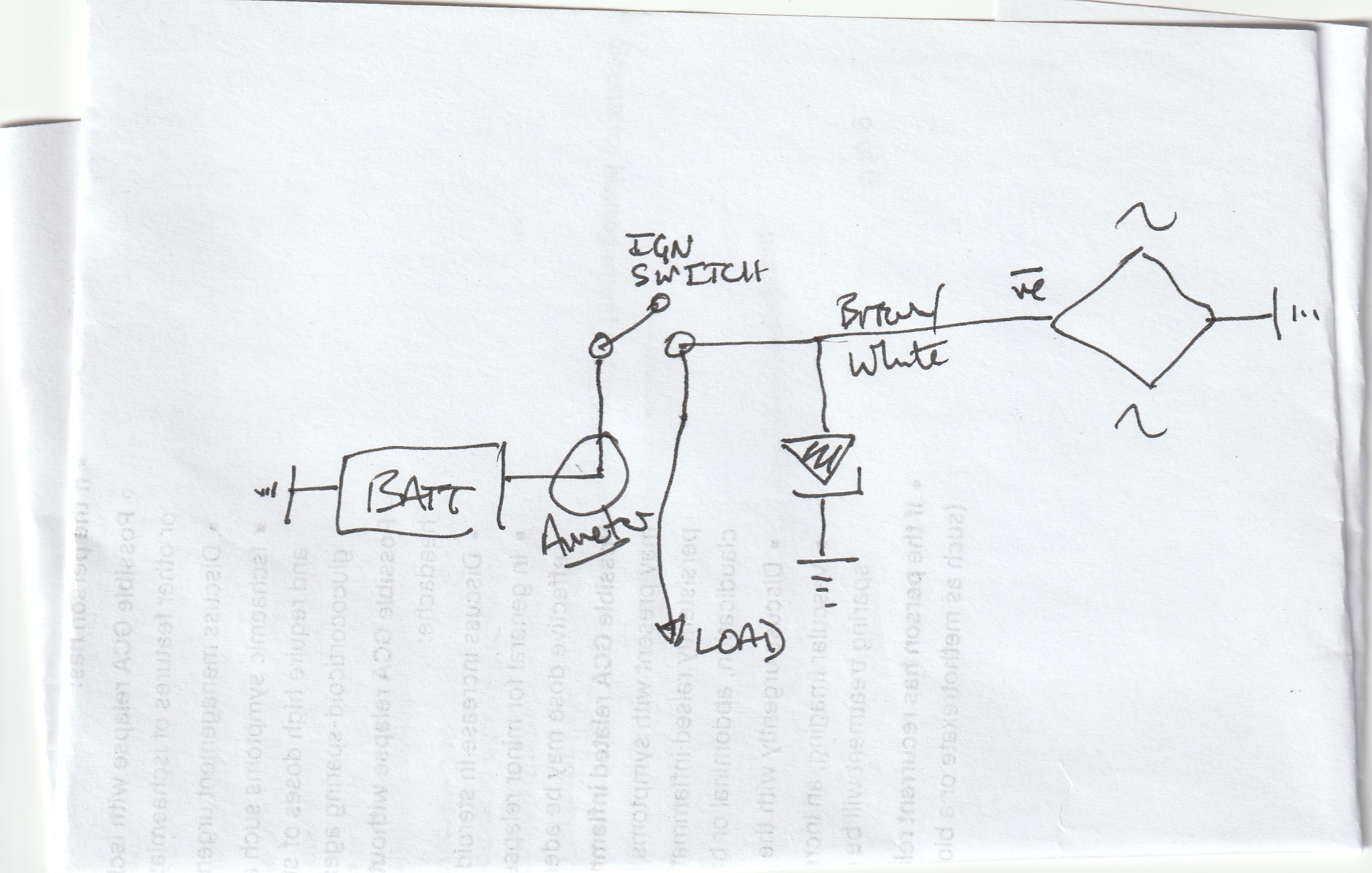
- Log in to post comments
Looks right for the ammeter…
Looks right for the ammeter.
Do you find the alternator tries to keep the engine running when you switch off the ign switch?
- Log in to post comments
No...
... it just stops dead. But remember the ignition circuit is powered from the auxiliary battery which is switched in by a relay from the ignition switch. So there is no direct connection from the charging side to the ignition circuit other than via the voltage sensitive relay.
- Log in to post comments
Has the 4 A charge been…
Has the 4 A charge been measured on any other, possibly more accurate gauge?
- Log in to post comments
No,
but it shows about 4 amps discharge with the headlight on and engine not running. Of course this doesn't include the ignition. Looks about right to me. I'm not actually bothered about the 4 amp charge which is around 48 watts or so so probably is being correctly limited by the Zener.
- Log in to post comments
extended throttle stop screw
Seems few knows that they exists. Solves the idle rev cold/warm problem.
Love the AMAL 622/169.
- Log in to post comments
This "Solves the idle rev…
This "Solves the idle rev cold/warm problem" for me.
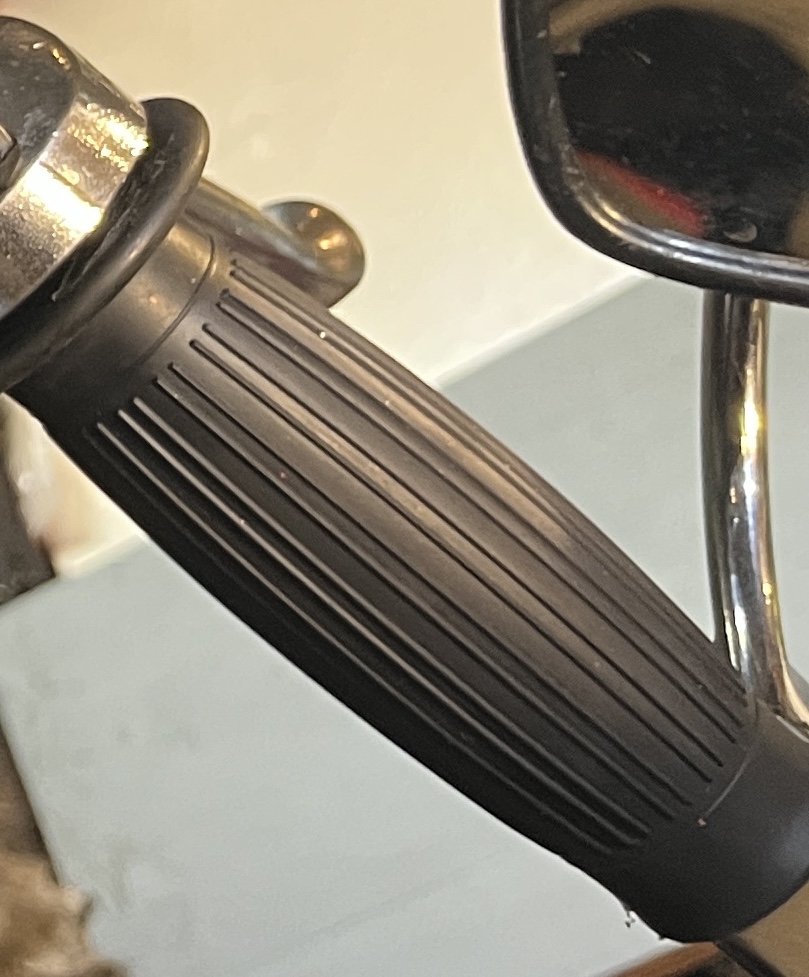
- Log in to post comments
I ordered the extended throttle stop
from Hitchcock on Wednesday and it arrived in the post on Thursday morning. Excellent service. Now fitted and it will make it easier to change on the fly. I assume Michael's photo is intended to show the friction adjuster on the twistgrip which I admit I rarely use these days having indicators on my bikes but I may think about it.
I'm also considering fitting a large thumbwheel on the extended throttle stop or even fashioning something like the fast idle stop on the pre-unit Amals fitted to old singles. I made something like this for the monobloc on my ES2.
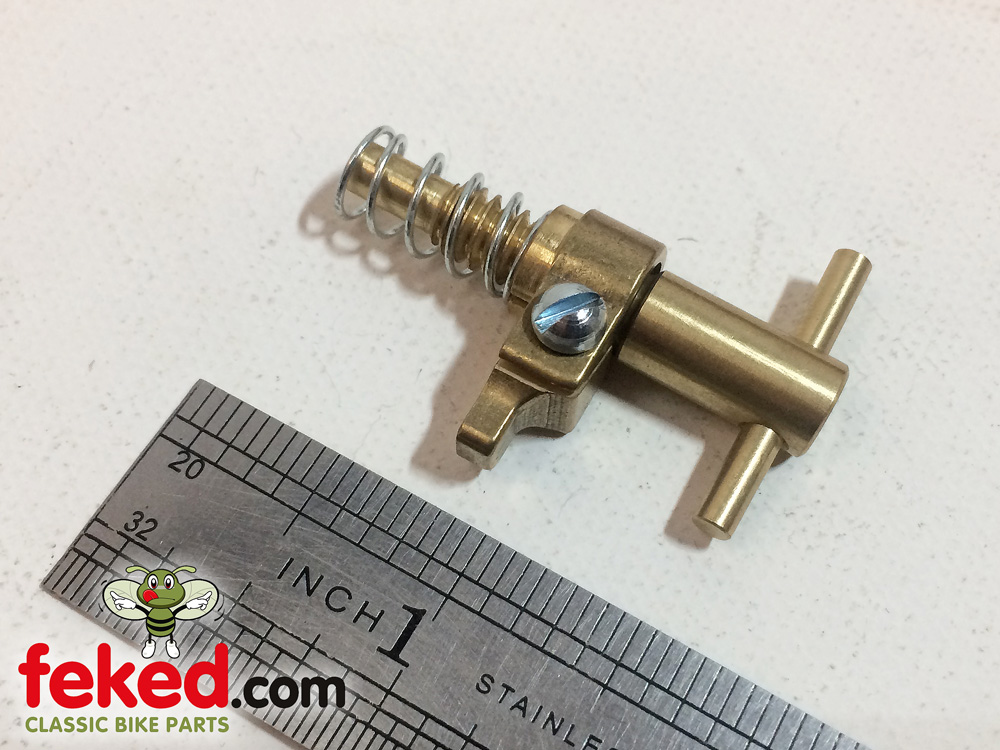
- Log in to post comments
Having an idle couple of hours...
... I decided to make a throttle stop similar in principle to the one illustrated. The extended one supplied by Hitchcock's was OK but lacked any way to return to a fixed (warm idle) position. Rummaging around in the scrap bin I found a length of phosphor bronze and a Schrader valve adaptor for Presto tyres as well as some 2mm aluminium sheet. I have a box full of discarded Amal carbs and parts which provided a throttle stop screw.
First I bored the outer end of the throttle stop screw with a 3mm drill. I then made a double diameter adaptor - one end went in the bored hole, the other fitted inside the Schrader adaptor. I then soft soldered it all together. I made a stop / pointer out of the alloy sheet and secured it to the adaptor with a valve stem securing nut. I should tidy up the adges of the stop/pointer and remove my marking out line!
This arrangement seems to work very well although have only tested it in the garage so have guessed at the warm idle setting Half a turn makes a significant difference in engine speed.
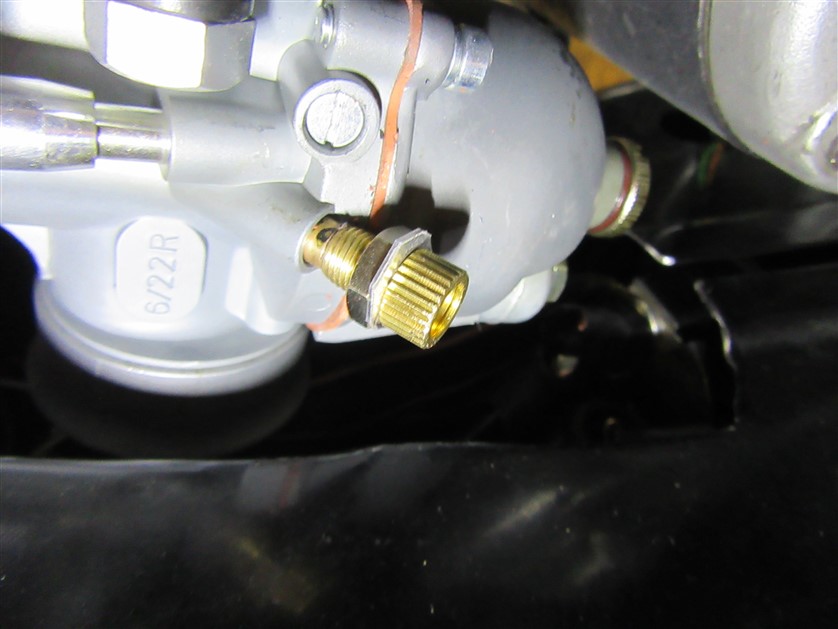
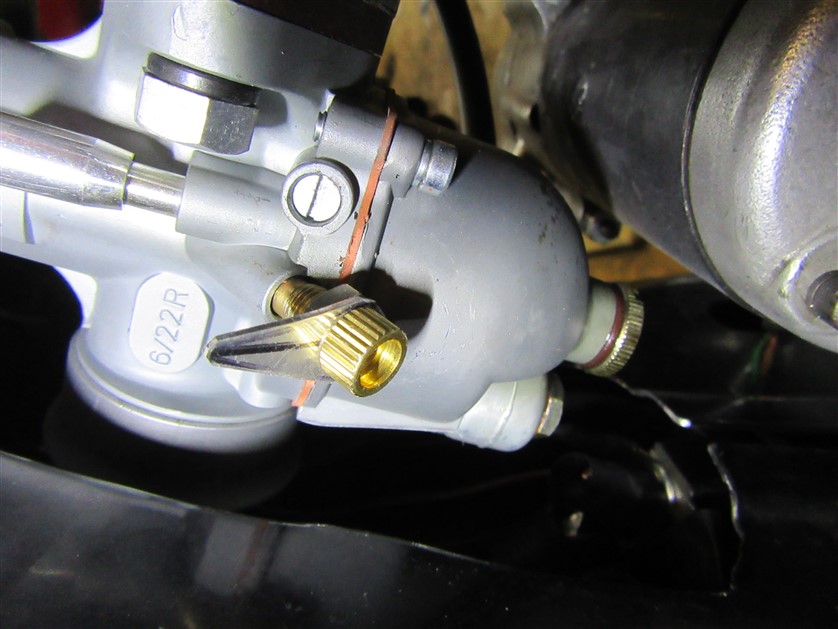
- Log in to post comments
Michael's photo just shows…
Michael's photo just shows the twistgrip.
I don't really get why we'd want anything else to control rpm and keep a cold engine running?
- Log in to post comments
Maybe not on a Norton
But when I start the Vincent on the rear stand, I need a cold tickover when going back and tighten the screw holding the rear stand. And if I have it on the left side stand it leans so much that it stalls. The 16H with it's spring retracting rear stand no problem.
- Log in to post comments
If the idle speed is set...
... with a warm engine as it should be then it's too slow when it's cold and the engine will just stop eg when left on the prop stand while I put my helmet and gloves on or at one of the many traffic stops I encounter in the first couple of miles from home. If idle speed is set higher to counter this then it's too fast when warm. The extended screw from Amal addresses this to some extent but requires very precise operation - not always easy as a quarter turn on the screw goes from slow idle to racing.
My device allows normal idle speed to be set precisely - the cold starting position is less critical and depends to some extent on ambient temperature. Many carburettors other than slide types have some sort of arrangement to increase idle speed on a cold engine.
This kind of device was standard on Norton and Velocette singles just post-war and I don't think it would have been offered unless riders found it useful. It was known as the easy starting stop and is described in Edgar Franks's book.
- Log in to post comments
Cold idle
In the days of carburettor, it was common to have a manual enrichment control.
When starting from cold the fuel does not vaporise properly and droplets enter the combustion chamber. The combustion is incomplete and some of the fuel remains unburnt and comes out with the exhaust gases.
With incomplete combustion less power is produced. At minimum throttle the engine stalls.
To counteract this an enrichment control is available so the engine is provided with enough fuel (excess fuel) to burn all the oxygen and still send unburnt fuel out of the exhaust.
With all the oxygen burnt, a tickover is restored to the cold engine.
As the vehicle engine warms up, the enrichment is disabled by the driver or rider. A skill soon acquired and which stops the engine stalling because of too little or too much fuel.
Now all done by the ECU. And the white exhaust fumes on a cold morning a thing of the past.
The 1969 fiat 128 is the only car I know that had a pull knob on the dash to operate the throttle. You could drive down the motorway with it, but all hell broke loose if you braked and de clutched. Crazy!! Foot pedal also provided.
I take it that some carbs are without enrichment devices for cold starting.
Peter
- Log in to post comments
People do things differently…
People do things differently. I put helmet and gloves on, start the bike and ride off.
Until the engine is warm enough to idle, I use the throttle to keep it from cutting out. Anyone who can't blip the throttle and use the front brake at the same time should practise until they can.
- Log in to post comments
Of course I can do that Michael.
having been riding for 60 years I think I know how to do it by now. However, I hate people sitting at traffic lights blipping the throttle unless of course they have a GP carb. I've always striven for a nice even tickover. Witness my ES2.
https://youtu.be/y6IMRXgZE8k?si=Ih5CzNHsmhGSgopV
Peter: of course the Concentric clone has an "enrichment device" otherwise known as an air lever. However, once started this is raised to a greater or lesser degree hence has no effect at tickover. Inevitably that tickover speed is lower with a cold or cool engine.
Whatever others think I find this sort of thing useful as did pre- and post-war Norton and Velo owners. If you don't like it that's fine. I posted in the probably incorrect belief that others may have been interested.
- Log in to post comments
Pretty sure my Fiat 126 had…
Pretty sure my Fiat 126 had a hand throttle.
Everything in the thread is informative and gratefully read.
I never knew there were bikes you had to take a walk round, to get them off the stand.
- Log in to post comments
Can I blip while braking?
Yes.
https://youtu.be/31FqpkF2PK0?si=paVNxG_74UdIDlgn
But not with the hand change Sunbeam, which is another bike you had to walk to the back to get it off the stand.....
https://youtu.be/nXeHqpRBJ1s?si=D8EMJa3q8tVac3QT
Re hand throttle: the Series 3 Land Rover I drove as an AA patrol in the early 1970s had one. Quite useful it was too. The Land Rover had a mechanical governor which hunted when idling in a quite pleasing manner.
- Log in to post comments
To some extent, I suppose…
To some extent, I suppose the rear and front stands would have been for the depressingly common punctures of the days when roads were strewn with lost horse-shoe nails and boot tackets.
The sporting gentleman on his hand change Sunbeam effortlessly performs clutchless changes, reaching over the tank to the gear lever, with his left hand.
- Log in to post comments




Is it worth trying SAE50 oil in the gearbox?